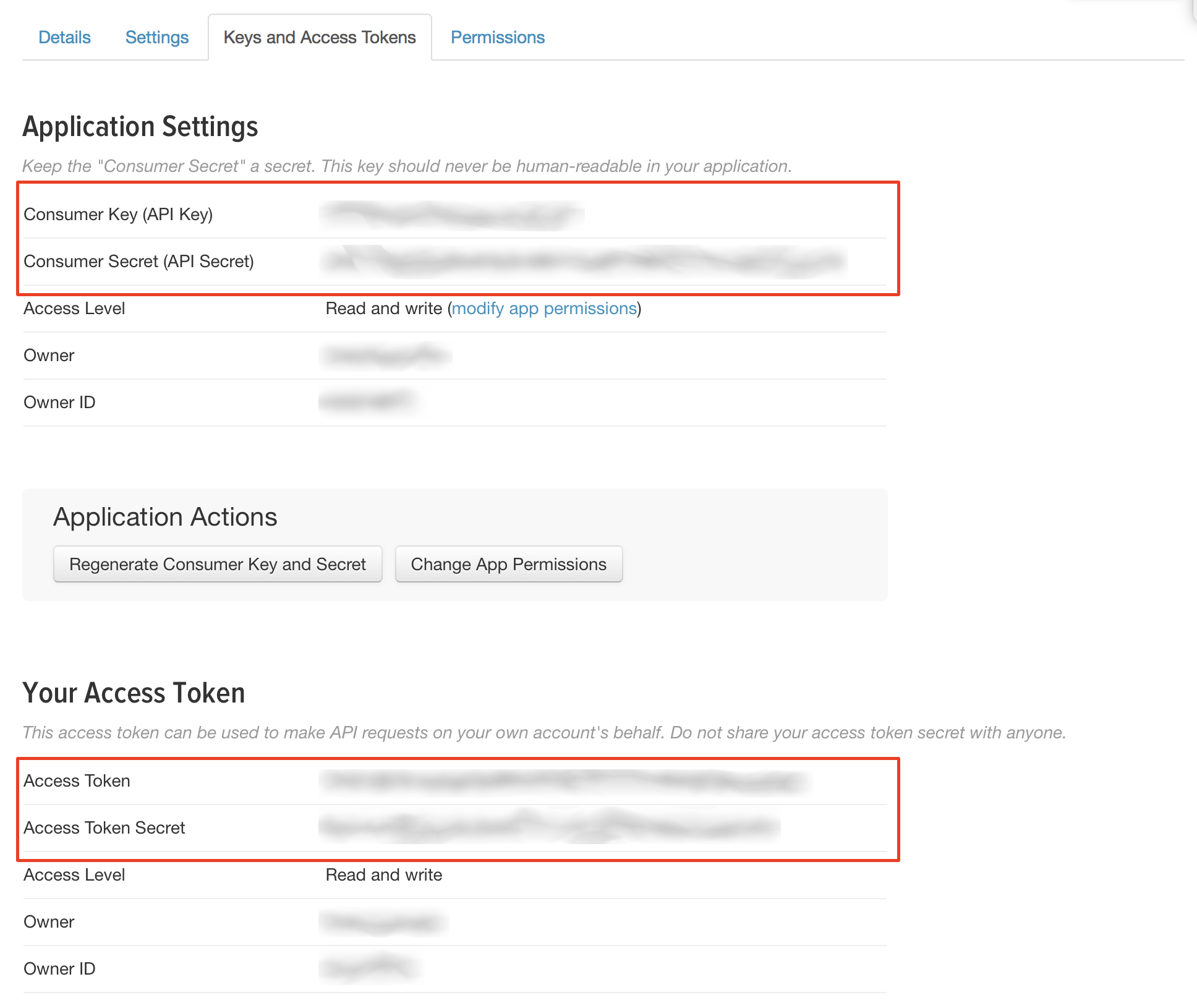C# / .NET Core, publish to Twitter
We needed to publish updates from our website to various social media. Later I will create posts describing all of them, but right now I’ll tell you how to work with Twitter from C# / .NET Core project.

Naturally, you need to have a Twitter account, where you will be publishing to. And to do that automatically, you need to create a Twitter app.
App and tokens
Go to Twitter Application Management and create new app there. Now open its Keys and Access Tokens. Copy the following values from there:
Consumer Key;Consumer Secret;Access Token;Access Token Secret.

Theory
Publishing (or any interaction with the Twitter API) is performed via HTTP requests. And each request to Twitter API should be authenticated and authorized using keys and tokens from above. The most interesting part here is generating signature for oauth_signature parameter, which is a fucking rocket science, if you ask me.
Fortunately, I found a ready solution on the internet. But this solution covers only publishing a text post, and I needed to attach a picture to it too, so I had to modify the code.
In order to publish your post with some image attached, you need to send two requests to Twitter API:
- Upload the image to Twitter and get its ID;
- Send your post with this ID in parameters.
Here’s an example of what you get:

Code
And that’s the class:
public class Twitter
{
readonly string _consumerKey;
readonly string _consumerKeySecret;
readonly string _accessToken;
readonly string _accessTokenSecret;
readonly HMACSHA1 _sigHasher;
readonly DateTime _epochUtc = new DateTime(1970, 1, 1, 0, 0, 0, DateTimeKind.Utc);
/// <summary>
/// Twitter endpoint for sending tweets
/// </summary>
readonly string _TwitterTextAPI;
/// <summary>
/// Twitter endpoint for uploading images
/// </summary>
readonly string _TwitterImageAPI;
/// <summary>
/// Current tweet limit
/// </summary>
readonly int _limit;
public Twitter(
string consumerKey,
string consumerKeySecret,
string accessToken,
string accessTokenSecret,
int limit = 280
)
{
_TwitterTextAPI = "https://api.twitter.com/1.1/statuses/update.json";
_TwitterImageAPI = "https://upload.twitter.com/1.1/media/upload.json";
_consumerKey = consumerKey;
_consumerKeySecret = consumerKeySecret;
_accessToken = accessToken;
_accessTokenSecret = accessTokenSecret;
_limit = limit;
_sigHasher = new HMACSHA1(
new ASCIIEncoding().GetBytes($"{_consumerKeySecret}&{_accessTokenSecret}")
);
}
/// <summary>
/// Publish a post with image
/// </summary>
/// <returns>result</returns>
/// <param name="post">post to publish</param>
/// <param name="pathToImage">image to attach</param>
public string PublishToTwitter(string post, string pathToImage)
{
try
{
// first, upload the image
string mediaID = string.Empty;
var rezImage = Task.Run(async () =>
{
var response = await TweetImage(pathToImage);
return response;
});
var rezImageJson = JObject.Parse(rezImage.Result.Item2);
if (rezImage.Result.Item1 != 200)
{
try // return error from JSON
{
return $"Error uploading image to Twitter. {rezImageJson["errors"][0]["message"].Value<string>()}";
}
catch (Exception ex) // return unknown error
{
// log exception somewhere
return "Unknown error uploading image to Twitter";
}
}
mediaID = rezImageJson["media_id_string"].Value<string>();
// second, send the text with the uploaded image
var rezText = Task.Run(async () =>
{
var response = await TweetText(CutTweetToLimit(post), mediaID);
return response;
});
var rezTextJson = JObject.Parse(rezText.Result.Item2);
if (rezText.Result.Item1 != 200)
{
try // return error from JSON
{
return $"Error sending post to Twitter. {rezTextJson["errors"][0]["message"].Value<string>()}";
}
catch (Exception ex) // return unknown error
{
// log exception somewhere
return "Unknown error sending post to Twitter";
}
}
return "OK";
}
catch (Exception ex)
{
// log exception somewhere
return "Unknown error publishing to Twitter";
}
}
/// <summary>
/// Send a tweet with some image attached
/// </summary>
/// <returns>HTTP StatusCode and response</returns>
/// <param name="text">Text</param>
/// <param name="mediaID">Media ID for the uploaded image. Pass empty string, if you want to send just text</param>
public Task<Tuple<int, string>> TweetText(string text, string mediaID)
{
var textData = new Dictionary<string, string> {
{ "status", text },
{ "trim_user", "1" },
{ "media_ids", mediaID}
};
return SendText(_TwitterTextAPI, textData);
}
/// <summary>
/// Upload some image to Twitter
/// </summary>
/// <returns>HTTP StatusCode and response</returns>
/// <param name="pathToImage">Path to the image to send</param>
public Task<Tuple<int, string>> TweetImage(string pathToImage)
{
byte[] imgdata = System.IO.File.ReadAllBytes(pathToImage);
var imageContent = new ByteArrayContent(imgdata);
imageContent.Headers.ContentType = new MediaTypeHeaderValue("multipart/form-data");
var multipartContent = new MultipartFormDataContent();
multipartContent.Add(imageContent, "media");
return SendImage(_TwitterImageAPI, multipartContent);
}
async Task<Tuple<int, string>> SendText(string URL, Dictionary<string, string> textData)
{
using (var httpClient = new HttpClient())
{
httpClient.DefaultRequestHeaders.Add("Authorization", PrepareOAuth(URL, textData, "POST"));
var httpResponse = await httpClient.PostAsync(URL, new FormUrlEncodedContent(textData));
var httpContent = await httpResponse.Content.ReadAsStringAsync();
return new Tuple<int, string>(
(int)httpResponse.StatusCode,
httpContent
);
}
}
async Task<Tuple<int, string>> SendImage(string URL, MultipartFormDataContent multipartContent)
{
using (var httpClient = new HttpClient())
{
httpClient.DefaultRequestHeaders.Add("Authorization", PrepareOAuth(URL, null, "POST"));
var httpResponse = await httpClient.PostAsync(URL, multipartContent);
var httpContent = await httpResponse.Content.ReadAsStringAsync();
return new Tuple<int, string>(
(int)httpResponse.StatusCode,
httpContent
);
}
}
#region Some OAuth magic
string PrepareOAuth(string URL, Dictionary<string, string> data, string httpMethod)
{
// seconds passed since 1/1/1970
var timestamp = (int)((DateTime.UtcNow - _epochUtc).TotalSeconds);
// Add all the OAuth headers we'll need to use when constructing the hash
Dictionary<string, string> oAuthData = new Dictionary<string, string>();
oAuthData.Add("oauth_consumer_key", _consumerKey);
oAuthData.Add("oauth_signature_method", "HMAC-SHA1");
oAuthData.Add("oauth_timestamp", timestamp.ToString());
oAuthData.Add("oauth_nonce", Guid.NewGuid().ToString());
oAuthData.Add("oauth_token", _accessToken);
oAuthData.Add("oauth_version", "1.0");
if (data != null) // add text data too, because it is a part of the signature
{
foreach (var item in data)
{
oAuthData.Add(item.Key, item.Value);
}
}
// Generate the OAuth signature and add it to our payload
oAuthData.Add("oauth_signature", GenerateSignature(URL, oAuthData, httpMethod));
// Build the OAuth HTTP Header from the data
return GenerateOAuthHeader(oAuthData);
}
/// <summary>
/// Generate an OAuth signature from OAuth header values
/// </summary>
string GenerateSignature(string url, Dictionary<string, string> data, string httpMethod)
{
var sigString = string.Join(
"&",
data
.Union(data)
.Select(kvp => string.Format("{0}={1}", Uri.EscapeDataString(kvp.Key), Uri.EscapeDataString(kvp.Value)))
.OrderBy(s => s)
);
var fullSigData = string.Format("{0}&{1}&{2}",
httpMethod,
Uri.EscapeDataString(url),
Uri.EscapeDataString(sigString.ToString()
)
);
return Convert.ToBase64String(
_sigHasher.ComputeHash(
new ASCIIEncoding().GetBytes(fullSigData.ToString())
)
);
}
/// <summary>
/// Generate the raw OAuth HTML header from the values (including signature)
/// </summary>
string GenerateOAuthHeader(Dictionary<string, string> data)
{
return string.Format(
"OAuth {0}",
string.Join(
", ",
data
.Where(kvp => kvp.Key.StartsWith("oauth_"))
.Select(
kvp => string.Format("{0}=\"{1}\"",
Uri.EscapeDataString(kvp.Key),
Uri.EscapeDataString(kvp.Value)
)
).OrderBy(s => s)
)
);
}
#endregion
/// <summary>
/// Cuts the tweet text to fit the limit
/// </summary>
/// <returns>Cutted tweet text</returns>
/// <param name="tweet">Uncutted tweet text</param>
string CutTweetToLimit(string tweet)
{
while (tweet.Length >= _limit)
{
tweet = tweet.Substring(0, tweet.LastIndexOf(" ", StringComparison.Ordinal));
}
return tweet;
}
}For more details about Twitter API go to the documentation:
And here’s how to use this class:
string ConsumerKey = "YOUR-CONSUMER-KEY",
ConsumerKeySecret = "YOUR-CONSUMER-KEY-SECRET",
AccessToken = "YOUR-ACCESS-TOKEN",
AccessTokenSecret = "YOUR-ACCESS-TOKEN-SECRET";
var twitter = new Twitter(
ConsumerKey,
ConsumerKeySecret,
AccessToken,
AccessTokenSecret
);
// 1) if we want to upload image and post it together with text
string response = twitter.PublishToTwitter("some text", "/path/to/some/image.png");
Console.WriteLine(response);
// 2) if want just to send text
//var rez = Task.Run(async () =>
//{
// var response = await twitter.TweetText("some another text", string.Empty);
// return response;
//});
//Console.WriteLine(rez.Result.Item1);
//var rezJson = JObject.Parse(rez.Result.Item2);
//Console.WriteLine(rezJson);
//string error = rezJson["errors"] == null ? "OK" : rezJson["errors"][0]["message"].Value<string>();
//Console.WriteLine(error);Later I also wrote an article about uploading videos.


Social networks
Zuck: Just ask
Zuck: I have over 4,000 emails, pictures, addresses, SNS
smb: What? How'd you manage that one?
Zuck: People just submitted it.
Zuck: I don't know why.
Zuck: They "trust me"
Zuck: Dumb fucks